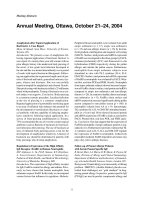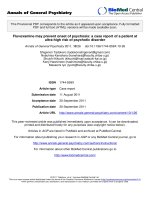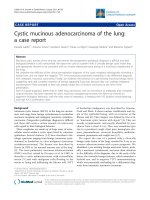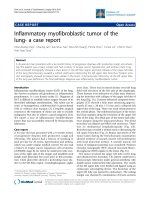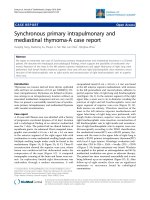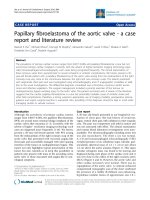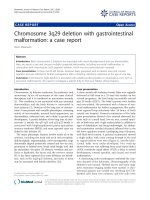Báo cáo y học: " Severe aberrant glenohumeral motor patterns in a young female rower: A case report" pptx
Bạn đang xem bản rút gọn của tài liệu. Xem và tải ngay bản đầy đủ của tài liệu tại đây (1.74 MB, 7 trang )
BioMed Central
Page 1 of 7
(page number not for citation purposes)
Chiropractic & Osteopathy
Open Access
Case report
Severe aberrant glenohumeral motor patterns in a young female
rower: A case report
Timothy W Stark*, Jessica Seebauer, Bruce Walker, Neal McGurk and
Jeff Cooley
Address: Health Science Division, Murdoch University, Murdoch, Western Australia, Australia
Email: Timothy W Stark* - ; Jessica Seebauer - ;
Bruce Walker - ; Neal McGurk - ; Jeff Cooley -
* Corresponding author
Abstract
Background: This case features an 18-year-old female with glenohumeral dysrhythmia and
subluxation-relocation patterns. This unusual case highlights the need for careful examination and
consideration to the anatomical structures involved.
Conventional approaches to shoulder examination include range of motion, orthopaedic tests and
manual resistance tests. We also assessed the patient's cognitive ability to coordinate muscle
function. With this type of assessment we found that co-contraction of local muscle groups seemed
to initially improve the patients abnormal shoulder motion. With this information a rehabilitation
method was instituted with a goal to maintain the improvement.
Case presentation: An 18-year-old female with no history of trauma, presented with painless
kinesiopathology of the left shoulder (in abduction) consisting of dysrhythmia of the glenohumeral
joint and early lateral rotation of the scapula. Examination also showed associated muscle atrophy
of the lower trapezius and surrounding general muscle weakness. We used an untested functional
assessment method in addition to more conventional methods.
Exercise rehabilitation interventions were subsequently prescribed and graduated in accordance
with what is known as the General Physical Rehabilitation Pyramid.
Conclusion: This paper presents an unusual case of aberrant shoulder movement. It highlights the
need for careful examination and thought regarding the anatomical structures and normal motor
patterns associated with the manoeuvre being tested. It also emphasised the use of co-contraction
during examination in an attempt to immediately improve a regional dysrythmia if there is suspicion
of a regional aberrant motor pattern. Further research may be warranted to test this approach.
Background and Methods
This case reports findings in an 18-year-old female who
presented with motion aberration (kinesiopathology) of
the left shoulder consisting of dysrhythmia of the gleno-
humeral joint and early lateral rotation of the scapula. To
ascertain what is known about this type of condition a lit-
erature search was conducted via the database PubMed
using the keywords "nontraumatic glenohumeral",
Published: 13 November 2007
Chiropractic & Osteopathy 2007, 15:17 doi:10.1186/1746-1340-15-17
Received: 13 July 2007
Accepted: 13 November 2007
This article is available from: />© 2007 Stark et al; licensee BioMed Central Ltd.
This is an Open Access article distributed under the terms of the Creative Commons Attribution License ( />),
which permits unrestricted use, distribution, and reproduction in any medium, provided the original work is properly cited.
Chiropractic & Osteopathy 2007, 15:17 />Page 2 of 7
(page number not for citation purposes)
"scapulohumeral", "subscapularis", "motor engram", and
"glenohumeral instability", with the limits: All Adult (19+
years), English, Clinical Trial, Meta-Analysis, Practice
Guideline, Randomised Controlled Trial, Review, Case
Reports, Humans, Core Clinical Journals. This search did
not return any case studies or clinical trials relating to this
type of shoulder dysfunction, but several articles discuss-
ing shoulder kinematics and rehabilitation were located.
Glenohumeral joint stability is primarily dependant on
muscle, hence it is often referred to as a muscular joint [1].
It is the most mobile joint in the human body, but the sac-
rifice for this mobility is stability, with glenohumeral
instability (and resulting dysfunction) being a common
finding [2]. While this anatomical arrangement predis-
poses the shoulder to traumatic changes, it is important to
remember that non-traumatic dysfunction can also occur.
Some cases relating to muscular imbalance of the gleno-
humeral and scapulothoracic joints [3] and faulty motor
patterns (or joint region coordination) [4] have been
reported. However none of these presented with findings
similar to the case being reported. It is worth considering
similar cases since many patients who present with shoul-
der pain continue to report pain 6–12 months later in
spite of treatment [5].
Matias, et al [6] found that the faulty scapular kinematics
of shoulder instability are perhaps related to suboptimal
muscular activity. For example Bak [3], Blaimont, et al [7],
Kuechle, et al [8], and Decker [9] all highlight the role the
subscapularis plays in shoulder instability. Other impor-
tant stabilizer functions of the shoulder region have been
identified, including normal facilitation of the rotator cuff
muscles and normal tone of the pectoralis major and del-
toid muscles [10]. Labriola [10] states that if the pectoralis
major and deltoid muscles are hypertonic, they also may
promote glenohumeral instability.
Current trends in shoulder rehabilitation are numerous,
varying from scapula-based [11] to kinetic chain [12] to
more neuromotor-based [13] processes. Concurrently,
shoulder rehabilitation protocols have been directed
towards specific shoulder complex conditions, to include
post-surgical [14], rotator cuff injury [15], and impinge-
ment [16]. It is claimed that inappropriate clinical atten-
tion to specific stabilizers, such as those that control the
scapula, may result in further altered mechanics of the
shoulder complex [17].
Stark [18] proposed a general physical rehabilitation pyr-
amid guide as a theoretical construct. The base of this pyr-
amid (Tier 1) is formed by a focus on cognitive
facilitation, static proprioception (posture), and faulty
mechanics correction. If motor coordination is learned
and other aberrant conditions are "corrected", the patient
is advised to progress through ascending levels of cardio-
vascular conditioning and dynamic proprioception train-
ing (Tier 2), stabiliser conditioning (Tier 3), mobiliser
conditioning (Tier 4), and ADL (activities of daily living)
conditioning (Tier 5).
This study reports the history, clinical examination, imag-
ing and the challenging choice of management of a
patient with an unusual shoulder movement dysfunction.
Case presentation
History
An 18-year-old athletically active female university stu-
dent presented to the Murdoch University Chiropractic
Clinic complaining of bilateral upper trapezius pain. She
commented that she thinks she is "double jointed"
because her shoulder "pops in and out of joint". The
patient stated that she had had this shoulder dysfunction
as long as she could remember. It had never caused her
pain or limited her activities of daily living (ADL's),
including rowing and playing stringed instruments; how-
ever she would prefer to not have the dysfunction. She
denied any shoulder trauma or knowledge of any per-
sonal or family history of connective tissue disorders. Rel-
evant medical history included a 20°C scoliotic curve at
11-years-of-age which progressed to 30°C in six months;
after being braced for 1.5 years the curve decreased to
24°C and stabilised.
Examination
The patient did not exhibit antalgia, and there was no
obvious deformity of the left shoulder apparent upon
static observation. Appearance and temperature of the
skin about the neck, shoulders, and thoracic region were
unremarkable, but generalised muscle tone and bulk at
the left shoulder were subjectively decreased when com-
pared to the right. Active range of motion (AROM) and
passive range of motion (PROM) of both shoulders were
full and pain-free in all directions. However, it was noted
that the patient's left shoulder appeared to subluxate (or
dislocate) and relocate from the glenoid fossa regularly
between 75°C and 180°C of abduction. This dislocation/
relocation pattern also appeared to occur to a lesser degree
during flexion of the left shoulder. Manual muscle testing
of the shoulder musculature revealed a mild weakness of
the left supraspinatus (4/5). The neurological examina-
tion was unremarkable. Impingement tests were negative
for pain, but excessive internal rotation of the left shoul-
der was demonstrated during Hawkins-Kennedy test [19]
when compared to the right. Anterior instability tests were
also pain-free, but positive for laxity on the left. A chiro-
practic examination did not reveal any suggestion of
manipulable lesions in the shoulder complex.
Chiropractic & Osteopathy 2007, 15:17 />Page 3 of 7
(page number not for citation purposes)
Functional examination
Observation of scapulohumeral rhythm revealed early lat-
eral rotation of the left scapula, possibly due to chronic
aberrant motor patterns including an early facilitation of
the trapezius musculature and delayed serratus anterior
and lower trapezius muscles. As a result, the normally
smooth arc of shoulder abduction between 75°C and
180°C was punctuated by sharp, clunking, jerking move-
ments which appeared to be due to the humerus repeat-
edly slipping from the glenoid fossa (see Additional file
1). The patient was instructed to co-contract her shoulder
during abduction. This involved training the patient to
contract the pectoralis minor, serratus anterior, subscapu-
laris, latissimus dorsi and lower trapezius muscles. This
complicated manoeuvre was facilitated by the clinician
lightly pinching the posterior axilla muscle groups (latis-
simus dorsi and lower trapezius) by placing her fingers in
the axilla from behind and having her thumb on the pos-
terior aspect of the lower trapezius muscle, and then ask-
ing the patient to "contract these muscles". While co-
contracting this muscle group and instructing the patient
to perform the abduction movement, it was noted that the
aberrant glenohumeral rhythm did not occur until the
end range of the movement. There were also fewer epi-
sodes of glenohumeral clunking, allowing the patient to
achieve a smoother arc of movement (see Additional file
2. Note: the patient performs abduction on the right dem-
onstrating a normal movement pattern. She then per-
forms an abduction manoeuvre on the left; first without
co-contraction, then a second time with co-contraction).
Radiological examination
Radiological investigation was ordered to rule out an ana-
tomical aetiology (such as shoulder joint dysplasia) and
confirm or deny an aberrant motor pattern as the sole
cause of dysfunction. This consisted of plain film radiog-
raphy and video fluoroscopy. A left shoulder series con-
sisting of AP internal rotation, AP external rotation, and
AP weighted (3 kg) neutral views (all taken in Grashey
position [20]) revealed no bony dysplasia (Figures 1, 2,
3). Video fluoroscopy consisting of AP and axial projec-
tions confirmed the suspicion that the humerus sublux-
ated inferiorly at the glenohumeral joint as it moved
through the abduction arc. The axial projection showed a
significant posterior component to this subluxation. A fol-
low-up projection AP projection with co-contraction of
the shoulder showed that these newly combined motor
patterns kept the glenohumeral joint stable, making the
arc of motion smoother, and reducing the dynamic sub-
luxation. When viewing the following videos note the sig-
nificant dysrhythmia for 4 repetitions followed by a
smoother rhythm from the patient's conscious facilitation
of co-contraction (see Additional file 3).
Clinical diagnosis
Chronic, severe, non-traumatic, multidirectional instabil-
ity of the left glenohumeral joint secondary to ligamen-
tous laxity. This was accompanied by glenohumeral
kinesio-pathology and aberrant scapulohumeral rhythm
due to suboptimal motor patterns.
We opine that this unusual presentation was associated
with facilitation of the upper trapezius with suspected
inhibition of the subscapularis, lower trapezius, latis-
simus dorsi, serratus anterior and possibly the remaining
rotator cuff. Without further EMG studies, this is simply
the author's clinical opinion.
Treatment Plan
Given the unusual presentation of this case, choice of
therapy was problematic. The patient expressed a disinter-
est in surgery to correct the potential capsular laxity. Con-
sidering the lack of pain and the chronicity of the
dysfunction, a conservative approach was recommended
to the patient.
The goals of treatment were to decrease the dysfunction in
her shoulder movement by improving the development
see attached jpeg file named "XRay 1"Figure 1
see attached jpeg file named "XRay 1".
Chiropractic & Osteopathy 2007, 15:17 />Page 4 of 7
(page number not for citation purposes)
of optimum motor patterns and improving muscular bal-
ance of the shoulder girdle.
Monfils, et al [21] state that "motor skill acquisition
occurs through modification and organization of muscle
synergies into effective movement sequences".
Because of the documented importance of muscle synergy
and the progressions of motor control and stabilizer func-
tion [18] we decided to employ the General Functional
Assessment Pyramid (Figure 4).
Re-assessment
The patient was seen fortnightly for several weeks and was
reassessed at every visit. The patient's initial trapezius
complaint resolved within the third treatment. The single
most important outcome measure utilised was the degree
of shoulder abduction (performed while co-contracting
the shoulder) obtained before dysfunction (subluxation-
relocation) resulted.
Degree of left shoulder abduction before subluxation-
relocation results are detailed in Table 1.
At six weeks it was also observed that the patient could
abduct her left shoulder to 105°C without conscious con-
traction of the glenohumeral and scapular stabilisers
before dysfunction resulted. That was an improvement
from the baseline of 75°C.
Discussion
This patient demonstrated unusual kinesiopathology of
the left shoulder (in abduction) consisting of dysrhythmia
of the glenohumeral joint and early lateral rotation of the
scapula. It is important in cases such as these to consider
the possible anatomical and functional causes of such a
disturbed motion pattern.
We chose to use an untested intervention to assist with
examination and treatment. We specifically instructed the
patient to cognitively (consciously) co-contract the shoul-
der girdle while performing an active range of motion
assessment. As it transpired the patient was able to cogni-
tively correct the dysrhythmia by co-contracting the shoul-
der. It is worth considering that in such patients there may
be a component of neuromuscular dysfunction causing
the multiple subluxation patterns.
see attached jpeg file named "XRay 3"Figure 3
see attached jpeg file named "XRay 3".
see attached jpeg file named "XRay 2"Figure 2
see attached jpeg file named "XRay 2".
Chiropractic & Osteopathy 2007, 15:17 />Page 5 of 7
(page number not for citation purposes)
The improvement during examination with co-contrac-
tion led the practitioners to suggest a rehabilitation proto-
col that was based on the patient's cognitive ability to co-
contract during activities of daily living and then subse-
quently to progress on to stabilizer motor control exer-
cises and strengthening.
As appreciated in the fluoroscopy video, there is apparent
premature scapular movement and an obvious inability
to stabilize the scapula and glenohumeral (GH) joint
throughout the abduction movement. Scapular dyski-
nesia is common, especially with impingement disorders
[22]. In order for the shoulder complex to function
smoothly, the scapula must have an adequate amount of
stability [17] as well as the GH joint [10]. This stability
may initially require cognitive facilitation of the scapula
stabilizers and the glenohumeral joint stabilizers.
Table 1:
DATE With conscious co-contraction of the left shoulder
Day 1 (baseline) 100
2 weeks 120
4 weeks 170
6 weeks 180
see attached pdf file named "Figure 4"Figure 4
see attached pdf file named "Figure 4".
Chiropractic & Osteopathy 2007, 15:17 />Page 6 of 7
(page number not for citation purposes)
Particular attention to the proximal-to-distal kinetic chain
[23] may further benefit the order of stability training
needed to establish an optimum motor pattern. As the
patient is attempting to re-train the necessary muscle func-
tion he/she may incorporate co-contraction of the region.
Co-contraction has been appreciated as a mechanism to
potentially enhance joint region efficiency during
moments of increased accuracy demand [13,24]. Co-con-
traction is a simple non-invasive manoeuvre that, as dem-
onstrated in this case, can be implemented as an
assessment element just as it can a rehabilitation element.
Although this patient's condition improved no conclu-
sion is drawn from it. However, the assessment and reha-
bilitation method was implemented in a logical sequence
for this case and could provide the basis of a hypothesis
for testing. The background information for this clinical
presentation was limited to one search engine. Further
resources should be utilized if a case series is considered.
The General Functional Assessment Pyramid and the Gen-
eral Physical Rehabilitation Pyramid used in this case
report has not been subjected to research testing. The pyr-
amids contain many parts. It may be that some parts are
effective while others are not, or indeed that the pyramids
are not effective at all.
Conclusion
This paper presented an unusual case of aberrant shoulder
movement that highlights the need for careful examina-
tion and thought regarding the anatomical structures and
neuro-motor patterns that may be involved or compro-
mised. It also emphasised the use of co-contraction during
examination in an attempt to immediately improve a dys-
rhythmia. While there are numerous treatments proposed
in the literature for shoulder dysfunction, few have been
held to the scrutiny of a trial [25]. We suggest that further
research take place with properly conducted trials on
groups of similar patients.
Competing interests
Dr. Tim Stark is the developer of the General Functional
Assessment Pyramid and the General Physical Rehabilita-
tion Pyramid used in this case.
Authors' contributions
All noted authors have read and approved the final man-
uscript.
TS is the primary author and provided literary content
involving history and current trends for shoulder rehabil-
itation. TS also consulted on this case providing the direc-
tion of patient examination and rehabilitation.
JS provided the on-going treatment and provided literary
content for the case.
BW provided guidance in drafting the manuscript.
NM provided guidance on fluoroscopy positioning and
patient imaging coordination.
JC provided clinical comment on the patient's plain film
radiographs and fluoroscopy and editing input.
Additional material
Acknowledgements
We would like to thank the patient for her additional time and efforts made
so we were able to acquire the multi-media material. The patient granted
permission, in writing for publication of this case. We would also like to
thank the Murdoch University Chiropractic Clinic co-Director, Lisa
Caputo, MEd, DC.
References
1. Muscolino J: Kinesiology: the skeletal systemand muscle func-
tion. 1st edition. Edited by: Fitzpatrick K. St. Louis , Mosby; 2006:684.
2. Kibler WB, McMullen J: Scapular dyskinesis and its relation to
shoulder pain. J Am Acad Orthop Surg 2003, 11(2):142-151.
3. Bak K: Nontraumatic glenohumeral instability and coracoac-
romial impingement in swimmers. Scand J Med Sci Sports 1996,
6(3):132-144.
4. Fremerey R, Bosch U, Lobenhoffer P, Wippermann B: Joint position
awareness and sports activity after capsulolabral reconstruc-
tion in the overhead athlete. Int J Sports Med 2006,
27(8):648-652.
Additional File 1
Video 1. Gross range of motion into bilateral abduction demonstrating the
aberrant glenohumeral rhythm.
Click here for file
[ />1340-15-17-S1.mov]
Additional File 2
Video 2. Gross range of motion into abduction; right shoulder normal, left
shoulder first demonstrates the aberrant glenohumeral rhythm, the patient
is instructed to co-contract the left shoulder complex resulting in an imme-
diate near-normal abduction rhythm.
Click here for file
[ />1340-15-17-S2.mov]
Additional File 3
Video 3. A fluoroscopy of the involved shoulder; the first four abduction
movements demonstrate the aberrant pattern specifically the early lateral
rotation of the scapula and multiple subluxation tendencies of the gleno-
humeral joint. The following four abduction repetitions demonstrate a
much smoother rhythm while the patient was co-contracting the shoulder
complex.
Click here for file
[ />1340-15-17-S3.mov]
Publish with BioMed Central and every
scientist can read your work free of charge
"BioMed Central will be the most significant development for
disseminating the results of biomedical research in our lifetime."
Sir Paul Nurse, Cancer Research UK
Your research papers will be:
available free of charge to the entire biomedical community
peer reviewed and published immediately upon acceptance
cited in PubMed and archived on PubMed Central
yours — you keep the copyright
Submit your manuscript here:
/>BioMedcentral
Chiropractic & Osteopathy 2007, 15:17 />Page 7 of 7
(page number not for citation purposes)
5. Kuijpers T, van Tulder MW, van der Heijden GJ, Bouter LM, van der
Windt DA: Costs of shoulder pain in primary care consulters:
a prospective cohort study in The Netherlands. BMC Muscu-
loskelet Disord 2006, 7:83.
6. Matias R, Pascoal AG: The unstable shoulder in arm elevation:
a three-dimensional and electromyographic study in sub-
jects with glenohumeral instability. Clin Biomech (Bristol, Avon)
2006, 21 Suppl 1:S52-8.
7. Blaimont P, Taheri A, Vanderhofstadt A: [Displacement of the
instantaneous center of rotation of the humeral head during
abduction: implication for scapulohumeral muscular func-
tion]. Rev Chir Orthop Reparatrice Appar Mot 2005, 91(5):399-406.
8. Kuechle DK, Newman SR, Itoi E, Morrey BF, An KN: Shoulder mus-
cle moment arms during horizontal flexion and elevation. J
Shoulder Elbow Surg 1997, 6(5):429-439.
9. Decker MJ, Tokish JM, Ellis HB, Torry MR, Hawkins RJ: Subscapula-
ris muscle activity during selected rehabilitation exercises.
Am J Sports Med 2003, 31(1):126-134.
10. Labriola JE, Lee TQ, Debski RE, McMahon PJ: Stability and instabil-
ity of the glenohumeral joint: the role of shoulder muscles. J
Shoulder Elbow Surg 2005, 14(1 Suppl S):32S-38S.
11. Rubin BD, Kibler WB: Fundamental principles of shoulder reha-
bilitation: conservative to postoperative management.
Arthroscopy 2002, 18(9 Suppl 2):29-39.
12. McMullen J, Uhl TL: A Kinetic Chain Approach for Shoulder
Rehabilitation. J Athl Train 2000, 35(3):329-337.
13. Myers JB, Wassinger CA, Lephart SM: Sensorimotor contribution
to shoulder stability: effect of injury and rehabilitation. Man
Ther 2006, 11(3):197-201.
14. Akalin E, Gulbahar S, Kizil R: [Rehabilitation of shoulder instabil-
ity following surgery]. Acta Orthop Traumatol Turc 2005, 39 Suppl
1:109-118.
15. Millett PJ, Wilcox RB 3rd, O'Holleran J D, Warner JJ: Rehabilitation
of the rotator cuff: an evaluation-based approach. J Am Acad
Orthop Surg 2006, 14(10):599-609.
16. Sauers EL: Effectiveness of rehabilitation for patients with sub-
acromial impingement syndrome. J Athl Train 2005,
40(3):221-223.
17. Voight ML, Thomson BC: The Role of the Scapula in the Reha-
bilitation of Shoulder Injuries. J Athl Train 2000, 35(3):364-372.
18. Stark TW: Introduction of a pyramid guiding process for gen-
eral musculoskeletal physical rehabilitation. Chiropr Osteopat
2006, 14:9.
19. Cleland J: Orthopaedic Clinical Examination: an evidenced
based approach for physical therapists. 1st edition. Edited by:
Kelly P. Carlstadt , Icon Learning Systems LLC; 2005:515.
20. Ronald Eisenberg CD & Chris May: Radiographic Positioning. 2nd
edition. Edited by: Schnittman E. Boston , Little, Brown and Company;
1995:411.
21. Monfils MH, Plautz EJ, Kleim JA: In search of the motor engram:
motor map plasticity as a mechanism for encoding motor
experience. Neuroscientist 2005, 11(5):471-483.
22. Kibler WB: Scapular involvement in impingement: signs and
symptoms. Instr Course Lect 2006, 55:35-43.
23. Kibler WB, McMullen J, Uhl T: Shoulder rehabilitation strate-
gies, guidelines, and practice. Orthop Clin North Am 2001,
32(3):527-538.
24. van Roon D, Steenbergen B, Meulenbroek RG: Trunk use and co-
contraction in cerebral palsy as regulatory mechanisms for
accuracy control. Neuropsychologia 2005, 43(4):497-508.
25. Green S, Buchbinder R, Hetrick S: Physiotherapy interventions
for shoulder pain. Cochrane Database Syst Rev 2003:CD004258.
